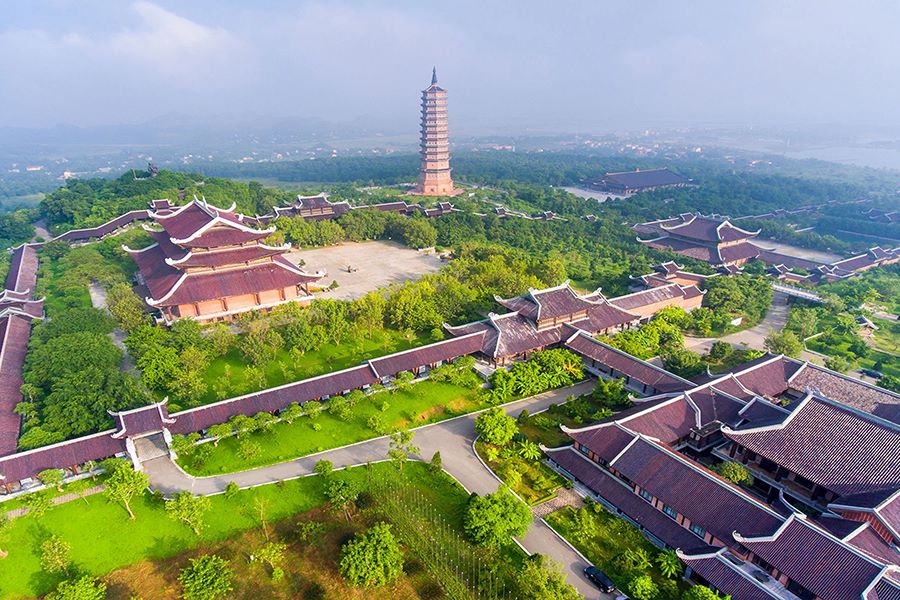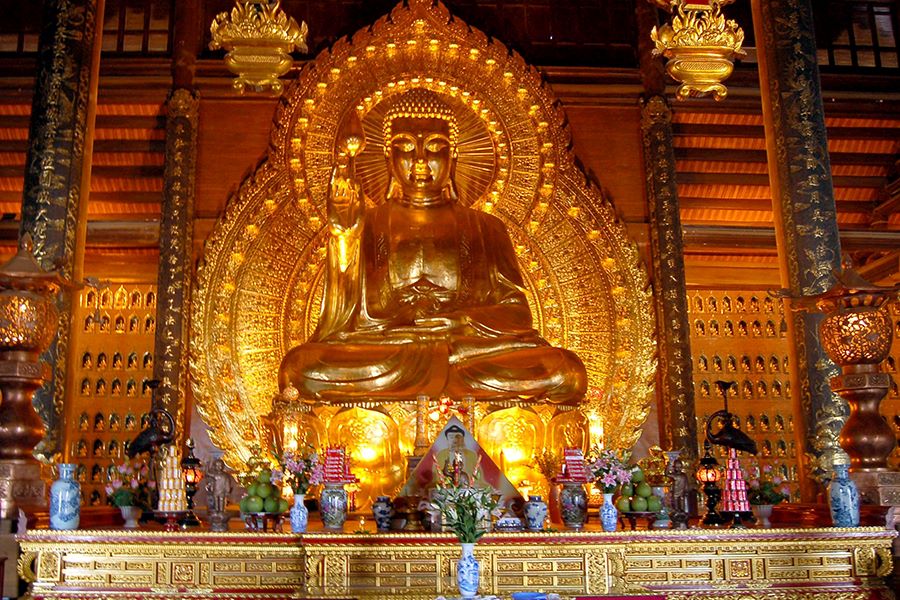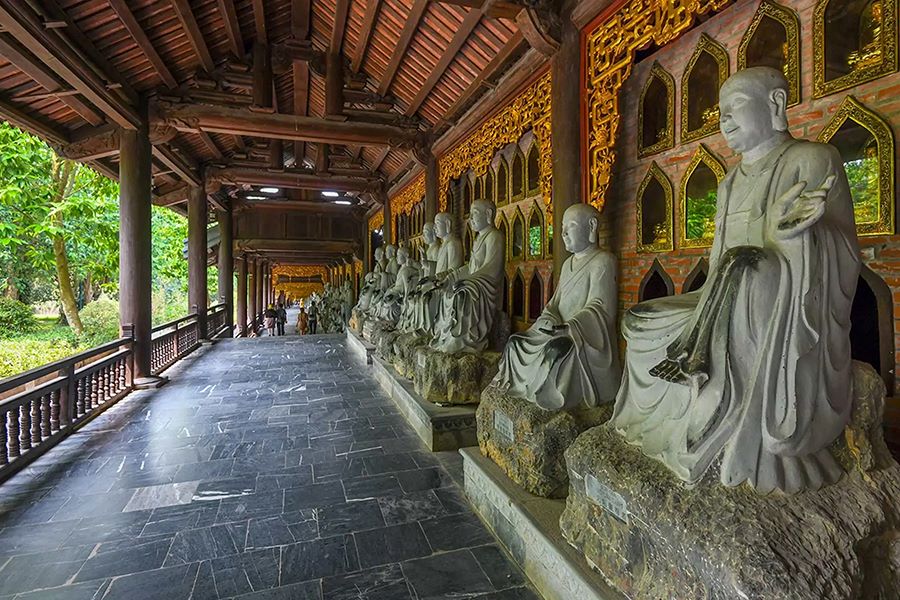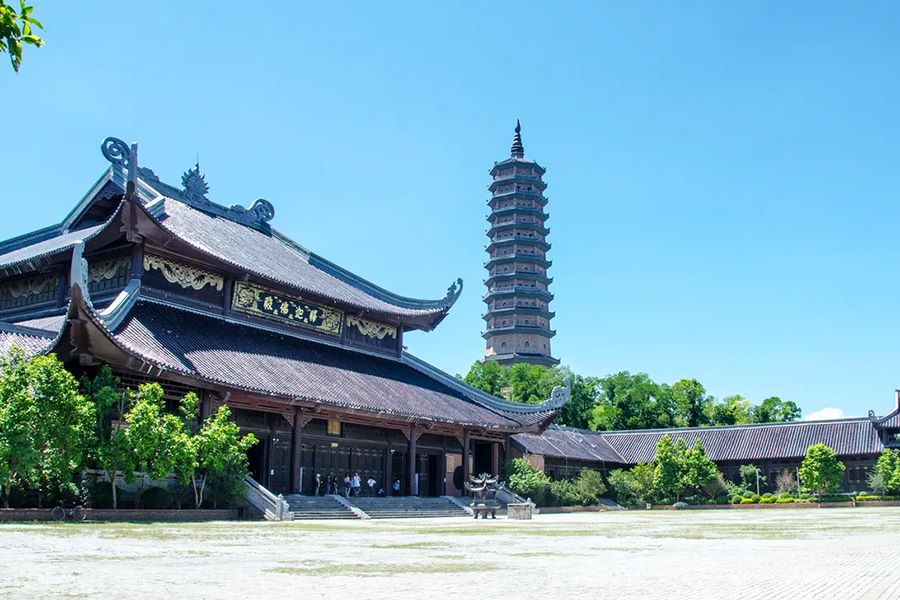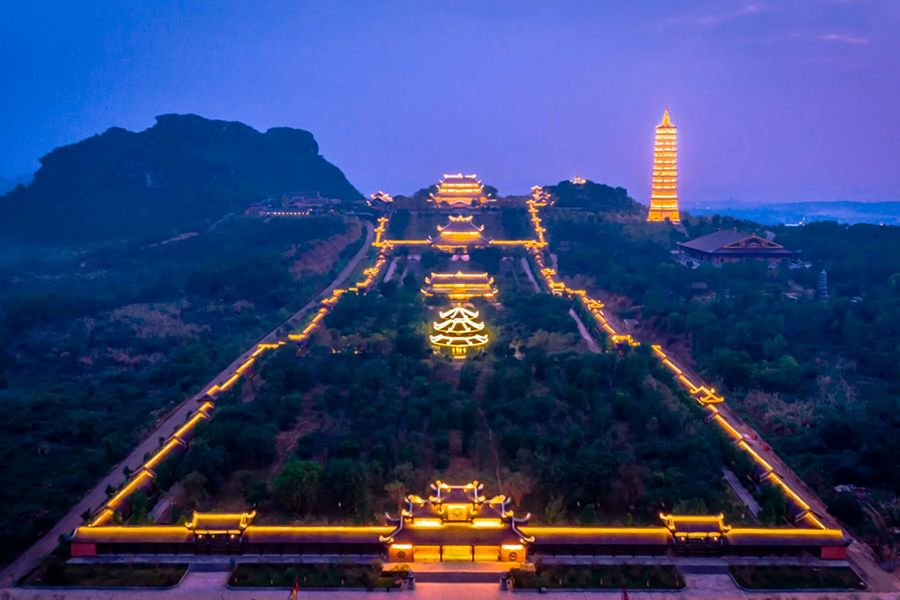Bai Dinh Pagoda is a famous Buddhist temple in Northern Vietnam. Get to know more about this place with our all-inclusive Bai Dinh Pagoda guide! Bai Dinh Pagoda in Ninh Binh Province is one of the most reputable religious destinations in Vietnam. Located close to Trang An Complex, a UNESCO World Heritage Site, it is undeniably a must-see for culture lovers. Below is the essential information about the pagoda that you should know before embarking on your journey.
The outstanding records of Bai Dinh Pagoda Ninh Binh
Bai Dinh Pagoda is renowned as one of the biggest temples in Southeast Asia. It is the holder of many national and regional records. As of 2012, the pagoda holds nine records, including:
- The largest gilded bronze Buddha in Asia
- The largest bronze Maitreya Buddha statue in Southeast Asia
- The largest bronze bell in Vietnam
- The tallest stupa in Asia
- The largest pagoda complex in Vietnam
- The longest Arhat corridor in Asia
- The largest number of Arhat statues in Vietnam
- The largest Pearl Well in Vietnam
- The largest number of Bodhi trees in Vietnam
About Bai Dinh Pagoda Complex in Ninh Binh Vietnam
Location, opening hours, entrance fee
Address: Gia Sinh Commune, Gia Vien District, Ninh Binh Province
Bai Dinh Pagoda opening hours: 6:00 AM – 10:00 PM every day
Bai Dinh Pagoda Ninh Binh, or Bai Dinh Temple Spiritual and Cultural Complex, is a Buddhist temple complex located on Bai Dinh Mountain in Gia Vien District, Ninh Binh Province, Vietnam. The complex consists of an ancient pagoda and a newly constructed, larger pagoda. The pagoda is a major spot for Buddhist pilgrims all across the country.
History
Buddhism was widespread and regarded as Vietnam’s major religion under three feudal dynasties: the Dinh, the Early Le, and the Ly in Hoa Lu (Ninh Binh) citadel.
Thus, during these periods, several pagodas were constructed in the region, notably the old Bai Dinh Pagoda on the western side of Dinh Mountain. The pagoda was built in the Dinh Dynasty, and it is where Emperor Dinh Tien Hoang erected a shrine to ask for favorable weather.
Other documents about Bai Dinh Pagoda’s history state that it was established in the Ly Dynasty as a place to contemplate, treat disease, and assist the locals. The pagoda has been described as one of the most important Buddhist, Taoist, and Mother Goddess worship sites.
Structure
The complex consists of two main sites: the newly built Bai Dinh Pagoda and the ancient pagoda.
The new Bai Dinh Pagoda Vietnam complex
The 700-hectare new Bai Dinh Pagoda is situated on Ba Rau Hill, close to Hoang Long River. This is a large complex with many buildings that were built between 2003 and 2010. The new pagoda’s architecture includes huge halls, gardens, and enclosures.
Bai Dinh Pagoda is distinguishable from other Vietnamese Buddhist pagodas due to its immense size. Tam The Hall, the largest structure here, has a height of 34 meters and a length of over 59 meters. The building materials consist of the local stones and timbers from Ninh Binh and the tiles from Bat Trang Village.
The curved finials and soaring corner eaves of the pagoda, which look like a phoenix’s tail, are typical of traditional Vietnamese architecture. Materials from traditional Vietnamese craft villages are used for the interior. These include the bronze sculptures from Y Yen, stone carvings from Ninh Van, woodwork from Phu Loc, and needlework from Ninh Hai.
The ancient Bai Dinh Pagoda
The original pagoda is located approximately 800 meters away from the new one in the foothills. The walkway stretches more than 300 stone steps before passing beneath an elaborate gate to reach the entrance. The actual pagoda is nestled in many tiny caves on the slope. Together with Buddhist deities, mountain spirits are also worshiped here.
Outstanding landmarks
- The Bell Tower: An octagon-shaped tower with three stories of varying sizes. The base has a diameter of 49 meters. The tower is 22 meters tall and supported by a platform in the shape of a lotus. Inside is a bronze bell weighing 36 tons.
The corridor with Arhat statues: The longest corridor in Asia that contains 500 Arhat Statues on both sides. - Gieng Ngoc (The Pearl Well): This moon-shaped well was constructed around 1,000 years ago. The diameter is 30 meters and the depth is 6 meters.
- The Hall of Bodhisattva Avalokitesvara: This seven-compartment ironwood construction is 14.8 meters tall, 40.4 meters long, and 16.8 meters wide. Inside is an 80-ton bronze figure of Bodhisattva Avalokitesvara with many eyes and hands adorned with gold.
- Bao Thap Tower: A 100-meter-tall, 13-story structure with 72 stair steps, housing sacred Buddha relics from India and Burma.
- Maitreya Statue: A 10-meter-tall bronze statue located on the highest hill of Bai Dinh Pagoda. Weighing 80 tons, it is the largest outdoor bronze Maitreya Statue in Southeast Asia.
When and how to get to Bai Dinh Pagoda Complex?
The best time to visit Bai Dinh Pagoda
The best time to take a Bai Dinh Pagoda tour is spring (from the first to the third lunar month). At this time of year, Vietnam weather in the north is exceptionally pleasant.
It is a great time to go sightseeing, take part in rituals at pagodas, and enjoy beautiful festivals at Bai Dinh Pagoda and Trang An Complex. The Bai Dinh Pagoda Festival also takes place in spring.
However, the peak tourist season is spring, and destinations are often overloaded. Hence, if you are not fond of crowds, it is better to choose another time to visit.
Tips for your best sightseeing to Bai Dinh Pagoda Vietnam
- Bai Dinh Pagoda dress code: dress politely
- Wear sneakers instead of high heels to walk around with ease
- Bring sunscreen, umbrellas, and rain jackets just in case
- Do not touch the statues
- Do not draw or carve on the statues and walls
Bai Dinh Pagoda is one of the most famous pagoda complexes in Vietnam and Southeast Asia. It is undoubtedly a worth-visiting place on any Vietnam culture tour. Hopefully, this travel guide to Bai Dinh will help you better prepare for your trip with local Vietnam travel agency!

